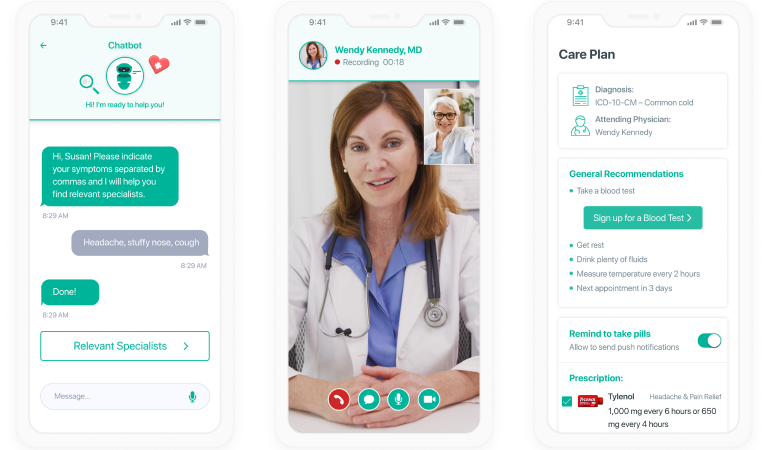Custom Telehealth Software for Nursing Care
Architecture, Key Features, Development Steps
Relying on 19 years of experience in healthcare IT, ScienceSoft designs and builds convenient telenursing products and helps healthcare providers implement reliable custom telenursing solutions.
Telenursing Essence
Using telehealth, nursing staff provides remote care, health state monitoring, and consultations on symptoms, disease management, rehabilitation, etc. Telenursing helps mitigate staffing issues and reduce re-admissions by 31% while ensuring continuous patient monitoring and care management.
Custom nursing telehealth software allows nurses to create and modify care plans according to each patient's unique needs. It also enables communication with interdisciplinary teams and ensures that the existing nursing processes and documentation requirements are aligned. Additionally, the software provides advanced analytics and reporting capabilities to assess patient outcomes, monitor KPIs, and identify areas for quality improvement.
The cost of developing a telehealth app for nursing care ranges from $150,000 to $300,000+. Use our free cost calculator to learn the software development budget for your case.
Telenursing Market Overview
In 2023, the telemedicine market was estimated at $87.21 billion. By 2032, it is expected to amount to $763.67 billion, growing at a CAGR of 28.3%. The market growth is associated with the increasing prevalence of chronic diseases, support of telehealth initiatives by authorities, and the need to save costs. Telehealth technology for nursing practice has become one of the key telemedicine directions due to the increased number of patients, nursing staff shortage, and work overload.
How Telenursing Works
Architecture

At the core of the telenursing platform, there is a cloud server with a data storage and processing module and a video streaming server. The former collects and handles for patient-related data (e.g., telenursing calls history, contact information, health records), telenursing staff data, images shared by patients and nurses in the app (e.g., photos of wounds), video calls recordings, etc. The latter enables real-time video communication between patients and nurses.
Other key modules of a telenursing solution include:
App for patients
including such features as nurse video visit scheduling, vitals entry, chat with a nurse, self-help guides, etc.
Admin web panel
to view a telenursing staff list, grant app access to patients and nurses, etc. (used by nursing supervisors, nurse practitioners, administrators of home care organizations).
App for nurses
featuring a patient list, patient health history, patient vitals tracker, nurse video visit request scheduling and approval, instant messaging with patients, etc.
A telenursing application can be integrated with EHR/EMR, CRM, hospital information system (HIS), and smart devices for patients, including wearables. Through automation of data collection from these devices, the app empowers a nurse to effortlessly track patients' vitals (e.g., blood glucose level, blood pressure) and continuously monitor their health state in real time.
Use Cases
Preoperative and postoperative patient care
Nurses track patients’ vitals using connected devices and guide patients through surgery preparation via video calls. After surgery, nurses assess patient recovery during e-visits and identify complications using photos and wearable device data.
Telenursing helps manage symptoms and track patients’ vitals, enhances care plan adherence, and enables nurses to support patients in symptom alleviation remotely.
A telehealth app provides nurses with real-time information about the health state of elderly patients or patients with special needs, and helps coordinate and adjust home care.
Pregnancy monitoring and newborn care
Via telehealth, nurses help patients navigate pregnancy, conduct childbirth preparation courses, and monitor parents’ and babies’ vitals.
Video calls with a psychiatric nurse help monitor medication adherence, timely identify and alleviate symptoms of mental health disorders, and promote healthy coping mechanisms among patients.
Should You Opt for a Custom Telenursing App?
To determine whether you should consider implementing a custom-made telenursing solution, answer a few simple questions from ScienceSoft’s healthcare IT team.
Do you need a solution that is specialized for your nursing practice? For example, it should follow the workflows of your healthcare organization, be tailored to a specific healthcare field (e.g., geriatric care, mental health, physical therapy).
Do you have a complex IT environment and need the telenursing app to be seamlessly integrated with your other software systems?
Do you need to implement advanced technologies or specialized capabilities? For example, voice recognition, image analysis, AI chatbots for patient support, or specific accessibility features.
Do you want to integrate your telehealth app with medical devices (heart rate monitors, glucose meters, etc.) to enable automated remote patient monitoring?
Should your telehealth app include a multilingual interface and automatic translation of in-app messages?
Tell us more about your needs
Please answer at least one question to help us better understand your business objectives.
A ready-made app will be more cost-effective
An out-of-the-box solution will likely suit your organization’s needs just fine. If you need expert guidance to choose and implement the best-fitting telenursing app, don’t hesitate to drop us a line.
A custom telenursing app is the best fit!
Based on the needs you shared, it looks like a custom telenursing app is the best option for you. ScienceSoft’s healthcare IT experts are ready to help you define the software requirements, design a robust architecture, and fully develop your solution.
Essential Features
Live video conferencing
Patients join online appointments with a nurse to discuss their health state and test results, get instructions on care and pre-surgical preparation, etc. In case of emergency, patients can also call an on-duty nurse.
Nurses track and assess patients’ vitals (collected by devices like biosensors, glucose meters, etc., or entered manually) and escalate the potential issues to the doctors.
Chat consultations
A patient can message a nurse to ask for medical advice (e.g., how to care for an injury) or to be referred to the right specialist.
Image and video sharing
By exchanging photos and videos with patients, nursing staff checks the healing process, monitors medication side effects, or shares instructions (bandage changing, exercise).
Nurse peer-to-peer support
Via a telenursing app, a nurse can contact an experienced colleague to discuss the unusual symptoms or complications.
Self-help guides for patients
An app can provide access to educational videos, first aid or exercise tutorials, and condition-related lifestyle advice for patients.
Key Steps to Develop Telenursing Software
In the healthcare IT industry for the past 19 years, ScienceSoft knows how to build efficient telenursing software.
1
Nursing needs assessment and feature set introduction
Our healthcare consultants elicit your unique requirements and define the software’s features, such as remote vitals monitoring and secure access to patient health records, and software quality attributes like scalability and usability.
2
Architecture and tech stack selection
Our solution architects choose the appropriate technologies, frameworks, and programming languages.
3
Project planning
We devise a detailed project plan, documentation and communication workflows.
4
Telenursing software development and testing
Our team codes the solution, implementing robust security mechanisms for PHI protection and ensuring full regulatory compliance, validates the software’s functionality (e.g., accurate capture and display of nursing assessments and interventions) and other important characteristics.
5
Integration
with other healthcare systems (e.g., EHR/EMR, nursing documentation and call systems) and smart devices (e.g., vital signs monitors, smart beds, and smart IV pumps).
6
Ongoing support and evolution
Including troubleshooting assistance and software updates to adapt to changing nursing practices or healthcare regulations.
Telehealth Nursing Challenges and Solutions
Challenge #1
Using a telenursing app can be challenging for some groups of patients, e.g., elderly patients. Treatment adherence may be hindered by a lack of positive reinforcement.
Check out the solution
Solution
While planning the application, focus on clear and user-friendly UI that won’t require additional user training. To verify that the interface is intuitive and easy-to-understand, allocate additional resources for usability testing. To motivate patients to use the app, ScienceSoft suggests implementing gamification techniques and in-app notifications to remind them of scheduled e-visits or regular vitals entry.
Hide
Challenge #2
Potential HIPAA breaches in a telenursing app may entail reputational and financial risks for healthcare organizations.
Check out the solution
Solution
HIPAA-compliant clouds (e.g., AWS, Azure) provide a secure environment for building a telenursing application, including EHR data storage in an encrypted database, storage of real-time patient monitoring data in the encrypted form, identity and access management, network and application firewalls, and more.
Hide
Real-Life Examples of Telenursing
Saint Luke's Health System, Missouri, introduced a program aimed at having virtual nurses supporting bedside nurses. The telehealth nurses took over non-hands-on care, education, documentation, admission, discharge, answering questions, reviewing the care plan, and more. As a result, patient and nurse satisfaction increased, and patients are now discharged within two hours of the discharge order (20% faster than in other hospital units).
Cleveland Clinic, a health system with several US and international locations, launched a telemedicine service that allows patients to get second opinions on their care and treatment plan. The program is run by nurse care managers who record additional patient health information and provide updates on the status of patients’ cases. As a result, 72% of secondary opinions identified a potential diagnosis change or treatment plan modifications.

BrightView Health, a behavioral health system with outpatient centers in Ohio, Kentucky, Virginia, and Delaware, launched a new EHR-integrated telehealth platform for their counseling and nursing teams in 2020. From Jan. to Nov. 2022, they doubled the 2021 telehealth visits record with over 1,300 online appointments.

Lee Health, Florida, implemented an EHR-integrated telemedicine solution with remote patient monitoring functionality. The system collects home patient data; designated nurses analyze it and escalate the cases if needed. Previously, 17% of remotely monitored patients needed a higher level of care, and now the numbers decreased to 3%-5%.
Do nurses need certifications to provide telehealth care?
American Association of Critical-Care Nurses (AACN) and the American Academy of Ambulatory Care Nursing (AAACN) do not recognize telehealth nursing as a separate nursing practice or subspecialty. In other words, telenursing can be easily implemented into everyday practice because nurses do not need additional certifications to use such apps.
Cost Drivers and Investments
General investment size factors
- Complexity and quantity of telenursing app functions (e.g., text chats, videoconferencing, chatbots, connected smart devices, VoIP communication, etc.).
- Number and complexity of needed integrations with third-party software (e.g., EHR/EMR, CRM, HIS).
Additional investment size factors
Connected medical devices (glucometers, biosensors, stethoscopes, pulse oximeters, etc.).
Operational costs
- Cloud services used in the telenursing app.
- Higher bandwidth for quality video consultations.
Learn more about telemedicine software development cost factors and ROI.

Based on ScienceSoft’s experience, the cost of a telemedicine nursing solution for healthcare providers ranges from $150,000 to $200,000+. Telehealth solutions generally reach 100% ROI in ~6-12 months (depending on the number of telenursing appointments, number of monitored patients, etc.). To develop an advanced telenursing software product, you will need from $250,000 to $300,000+ in investments.
Want to understand the cost of your telehealth software for nursing care?
Technologies ScienceSoft Uses to Build Reliable Telenursing Platforms
Telenursing Software by ScienceSoft
ScienceSoft brings in 19 years of experience in healthcare software development to help you implement high-quality software for remote nursing care. You set goals, we drive the project to fulfill them in spite of time and budget constraints, as well as changing requirements.
Our Awards and Recognitions

Listed among Healthcare IT Service Leaders in 2022 and 2024
Growing faster than Amazon, Google, and ServiceNow
Recognized for reliability and trustworthiness
Recognized by Health Tech Newspaper awards for the third time

Top Healthcare IT Developer and Advisor by Black Book™ survey 2023
Best in class in medical device connectivity (2023)
A top outsourcing provider for three consecutive years
ISO 13485-certified quality management system
ISO 27001-certified security management system
What makes ScienceSoft different
Driving success in healthcare IT projects no matter what
ScienceSoft develops healthcare IT solutions that reduce care delivery costs and improve outcomes, no matter the challenges posed by diverse expectations of medical staff, shifting priorities, and resistance to change.
About ScienceSoft
ScienceSoft is a US-headquartered IT consulting and software development vendor with 35 years of experience. Holding ISO 13485 certification and being experienced in the development of HIPAA-compliant software, ScienceSoft develops reliable telemedicine software for various use cases, including nursing care.







